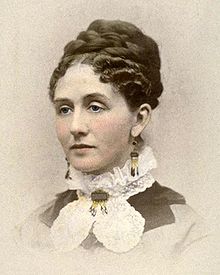- Sarah Brown Ingersoll Cooper
-
Sarah Brown Ingersoll Cooper (December 12, 1835 – December 11, 1896) was an American philanthropist and educator.
Born in Cazenovia, New York as the eldest of three daughters, she was educated at the Cazenovia Seminary and the Troy Female Seminary. She met her future husband, Halsey Fenimore Cooper, at Cazenovia, and the couple were married in 1855. The couple moved to Chattanooga, Tennessee and worked as editors on The Advertiser, with Sarah assisting Halsey. They had daughters Harriet (1856) and Mollie (1861) before they were forced to flee the south at the start of the Civil War.[1]
They briefly settled in Washington D.C., then moved to Memphis, Tennessee in 1863. In 1864, after her daughter Mollie died, Sarah began to suffer from depression and illness. For two years she attempted to recuperate in St. Paul, Minnesota, then she recovered when the family moved to San Francisco in 1869, where Halsey worked for the IRS.[1]
At her new home, Sarah became a teacher at the Bible Class of the Calvary Presbyterian Church. She founded the Jackson Street Kindergarten Association in 1879, then went on to open the first Kindergarten in the American West.[1]
In 1879, Halsey lost his job as Deputy Surveyor and the family suffered financial difficulties. As a result of the strain, he committed suicide in 1885. After attempting to clear her husband's name, Sarah continued her philanthropic career. She taught both the Bible School and Kindergarten, and was involved with women's rights groups. Her daughter had quit her teaching job to assist Sarah, but suffered from bouts of depression, especially following the death of her father. Harriet asphyxiated her mother and herself on December 11, 1896.[1][2]
References
- ^ a b c d Staff (2003). "Guide to the Sarah Brown Ingersoll Cooper Papers, 1813-1921". Cornell University Library. http://rmc.library.cornell.edu/EAD/htmldocs/RMM06543.html. Retrieved 2007-11-28.
- ^ Staff (December 12, 1896). "They Met Death Together". The New York Times. http://query.nytimes.com/gst/abstract.html?res=9B06E2D8103BEE33A25751C1A9649D94679ED7CF. Retrieved 2007-11-28.

This biographical article about a philanthropist is a stub. You can help Wikipedia by expanding it.

